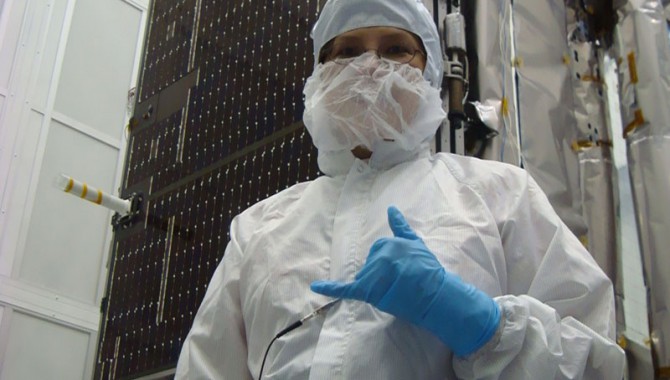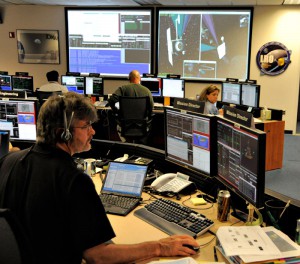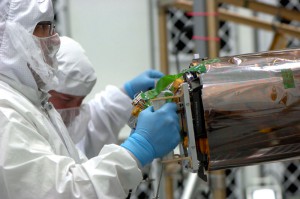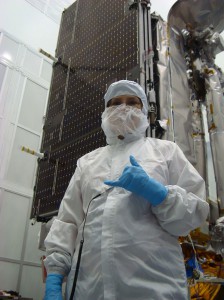
By Cathy Peddie
When Craig Tooley, the Lunar Reconnaissance Orbiter (LRO) project manager, offered me a job as his deputy, I reacted as I had to all decisions that have a great impact on my life: I slept on it and looked at it in the cold, cruel light of dawn.

Goddard’s Laser Ranging Facility directs a laser toward the LRO spacecraft in orbit around the moon.
Photo Credit: Goddard Space Flight Center/Tom Zagwodzki
As I left his office, he had asked me if I was ready to follow him to the moon. I thought, catchy sales pitch, but I’m still following my process. I made the right decision the next day, accepting the position. Being the LRO deputy project manager has been one of the best experiences of my NASA career. LRO was launched on June 18, 2009. Flying in a 50 km polar orbit above the moon’s surface, the orbiter will collect data sets for a year from seven instruments to provide a comprehensive atlas for future exploration. How cool is it to have been part of a historic mission that took NASA and the United States back to the moon after forty years?!
Craig and I are different; we came to our partnership with complementary skills that proved to be a good formula for managing LRO. As in any relationship, we started out knowing the obvious differences but discovered others as we went along. Craig’s mechanical background and interests came into play when we divided the project into our “watch areas” to help us meet the demanding LRO schedule. He took on the mechanical, thermal, and post-integration and testing areas, while I focused on project management, systems engineering, and mission operations.
Typically NASA projects do not staff adequately in the early stages. We like to keep them lean (and sometimes mean) until funding or other avenues are provided. Deputies are brought on when the go-ahead is given or the project manager screams for help. On LRO, I was brought in just prior to the preliminary design review (PDR) after a series of organizational and political changes drove the need for an expanded project office and additional staff.
I have had deputy positions before—as deputy project manager, deputy program manager, deputy chief, and deputy director. But in the midst of the LRO preparation for launch and early mission, moments of reflection brought home things that my mentors, family, and friends had been telling me all along. My thoughts on some common themes and threads in the variety of deputy positions I’ve held may be useful to those who are deputies or those who want to become deputies, or to help some decide that they don’t ever want to become one!
Roles and Expectations
My general approach to each deputy position is to try to act the way I would want a deputy to work with me if I ever get lucky enough to be in a position to have a deputy myself. One of the first things I like to do is sit down with my new boss and talk about our expectations. I like to know why a deputy was needed, what environment we’re in, why they hired me, and what they want from me. Expectations are a two-way street. The deputy also comes with a set of expectations, including what they want from the job, what skills and experience they bring to the table, and what they can offer that may not have been thought of previously. I like to do this on day one or even earlier to open the door for frank, interactive communication right away.
It is important to establish how you are going to work together to get everyone going in the right direction. Establishing roles and responsibilities helps alleviate confusion from the beginning. On LRO, we started with obvious project-manager and deputy-project-manager divisions of labor, knowing our roles would evolve as we learned more about each other and as project demands would dictate. Having worked on projects for many years, I took on the “easy” things in the project’s daily task listing while I came up to speed on what LRO needed. Within the first couple of months, I took care of the project management stuff the project manager had not had time to do (project plan, procurement shepherding, establishment and revamping of risk management and configuration management processes, and lead for the critical design review [CDR] that came eight months after PDR).
If you don’t define roles and responsibilities clearly, you can run into the “too many cooks in the kitchen” syndrome and other confusions, conflicts, and inefficiencies. To make effective use of the deputy, it is crucial to delineate roles, responsibilities, and lines of authority and, above all, to communicate, communicate, communicate. Close communication between the deputy and his or her boss remains essential throughout the life of the project to make sure you stay on the same wavelength. That may mean talking every day, texting, using Facebook or Twitter—whatever works for the people involved.
On LRO, we had to implement a “divide and conquer” strategy in order to meet the aggressive schedule. Unfortunately, this meant that there had to be a separation not only in duties but geographical locations between the project manager and me. Keeping project activities going in concert under the circumstances presented a tremendous management challenge. Constant communication and support were crucial. When manager and deputy have a shared knowledge and understanding of what the project needs, the deputy can step in instantly when needed.
Like any relationship, the manager-deputy relationship needs to be worked at continually. Lines of authority along with areas of responsibility must be clearly understood by all and worked out for the benefit of the project. In organizations and teams, people will sometimes try to play one off the other, like kids playing mom off dad. If they don’t like your decision they may try out the other “parent.” It is important to understand where authority resides. Above all, the deputy must be supported. I have always said, “The minute I’m not supported is the minute I can’t help.”
Using Differences

LRO Project Manager Craig Tooley examines data on LRO’s orbit insertion around the moon.
Photo Credit: NASA
It is important to take advantage of differences in management styles, skills, and strengths and weaknesses in the context of the team environment. I have never been a clone of the person I was the deputy to. In fact, being different is often cited positively in my performance appraisal. In all my deputy positions, those differences have worked well for me and my bosses. Groupthink is a real danger in programs, projects, and organizations. Having a different perspective can help management see all sides of situations to make the best decisions possible.
The LRO project manager had worked with many of his team members for decades. I was the outsider who didn’t grow up either with them or at Goddard. He was concerned about groupthink on the project and didn’t want a “yes” person. This was challenging for both of us, as the inevitable human dynamics came into play when the “outsider” had a different opinion. You don’t have to be belligerent about it, but you have to be able to provide that different perspective and say, “Before we make that decision, have you thought of …. ” It takes courage to speak up and do what’s best for the team, the project, and the person you are deputy to, as well as yourself. Most of the LRO team did not have experience in mission operations and extended missions. They often did not understand nor want to focus on aspects beyond integration, testing, and launch. It often felt like a trial by groupthink to have to prove the need for focus on the requirements of LRO’s unique mission to the moon. Understanding and appreciating that need came only after the orbiter reached its destination and successfully transmitted data back.
Ascertaining each other’s management style (how each of you deals with people as well as managing the organization and project) will help ensure that the deputy and primary person play to one another’s strengths and offset weaknesses. This assessment will help both determine how best to work together and how to deploy themselves when they inevitably need to divide and conquer to get the job done. It is also important to take the team environment into account. Managing a NASA in-house team is very different from managing a prime contractor, international team, or a virtual team with members across the country. Different styles and techniques are needed in each situation.
As a “people person,” one of the first things I do in any job is get to know the folks I am going to work with. Knowing your people and what is going on in the organization can definitely help ensure things are running smoothly and give your boss a perspective that helps him or her make informed decisions.
Flexibility

A technician integrates one of the Lunar Reconnaissance Orbiter’s narrow-angle camera instruments. (Click image for close-up) Photo Credit: NASA
Deputies wear many hats. They can be the backup or stand-in when the primary person goes on travel or is out sick or on vacation. They can be designated technical lead to focus on a particular area, lead a tiger team, troubleshoot an area, or pull the whole thing together. A deputy can be a business lead, ensuring that all the business processes are working well and the project stays within cost and schedule. They can also own project processes, ensuring that those processes work for the project, rather than dominate it. On LRO, I revamped the configuration management and risk management processes, making them tools that helped LRO as opposed to just “check the box” items or bureaucratic burdens.
A deputy can be a coach, helping team members work together to make the most of their diverse skills mix. They can be supportive, giving the much needed pat on the back that lets the team know when they are doing a good job. In this same vein, a deputy can be a trainer or mentor to those on the team. Sometimes people need a counselor, too. I often wish I had a psychology degree in addition to my engineering degree, since they don’t really teach you about people skills in engineering school. You just figure it out along the way, or are lucky enough to have those skills to begin with. I swear there is an enormous sign above my office door that says, “Complaints Department.” I’ve been trying to get rid of it for years! People may be afraid to speak to the boss to say things like, “Hey, you’ve messed up,” or, “Let’s try a different way.” A deputy can be an emissary for someone who may be too afraid to speak up.
Many times a deputy is the lead pooper scooper, ensuring that things get cleaned up. They are the “closer” in some situations, tying up loose ends—a critically important project function.
The Power of Two
Having a deputy means having someone to share the burden and the workload. I’ve often told my bosses, “You are not alone. I’ve got your back, go ahead and do what you need to do.” Having a deputy means having a readily available second opinion, another viewpoint, and a sounding board. Before a project manager makes a decision he or she may want to try it out on a trusted sidekick first—someone who won’t hesitate to tell the truth. The combination of the manager’s and deputy’s different skills can make a dynamic duo and high-performing management team. Ensuring that you make the best use of that person you brought onboard can pay huge dividends.
The LRO project experience helped bring home all these lessons for me. My project manager and I were partners, our skills were complementary, and we evolved our relationship throughout the project. We were flexible in how we worked and continued to shift and evolve as the situation demanded. Those things and our common passion for LRO helped us manage a historic project successfully.
About the Author
 |
Cathy Peddie is the deputy project manager for the Joint Dark Energy Mission project. She has enjoyed working on a variety of NASA projects and programs in both space and aeronautics. Prior to coming to NASA, she was in the U.S. Air Force working on spaceflight programs. |









